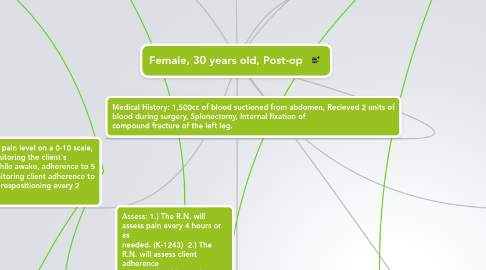Female, 30 years old, Post-op
by Jaime St.James

1. Assess: 1.) The R.N. will assess pain every 4 hours or as needed. (K-1243) 2.) The R.N. will assess client adherence to deep breathing and coughing methods every 4 hours or as needed. (K-982) 3.) The R.N. will assess client adherence to repositioning every 2 hours or as needed. (k-983) Independent: 1.) The R.N. will administer prescribed pain medication as needed. (K-1243) 2.) The R.N. will assist client to a sitting position on bed before deep breathing or coughing. (K-982) 3.) The client will use side rails to aid in repositioning. (K-966) Teaching: 1.) The R.N. will teach the client use of non pharmacological techniques. (K-1243) 2.) The R.N. will teach client to splint incision with pillow when coughing and deep breathing. (K-982) 3.) The R.N. will teach the client to practice turning and repositioning in bed prior to surgery. (K-983) Collaboration: 1.) The R.N. will collaborate with doctor's orders regarding prescribed pain medication. (K-1243) 2.) The R.N. will collaborate with doctor's orders regarding medicating prior to coughing and deep breathing.(K-1243) 3.) The R.N. will collaborate with the doctor's orders regarding medicating prior to repositioning. (K-1243)
2. Rationales: Assessment: 1.) Pain is a subjective experience and must be described by the client in order to plan effective treatment. (K-1243) 2.) Coughing and deep breathing helps prevent pneumonia and atelectasis. (K-982) 3.) Turning alternates which lung can achieve maximum expansion. (K-983) Independent: 1.) Each person experiences and expresses pain in an individual manner. (K-1243) 2.) When in sitting position gravity pulls the diaphragm downward allowing greater chest expansion and greater lung ventilation. (K-1150) 3.) Using side rails aids in early ambulation. (K-966) Teaching: The use of non invasive pain relief measures can increase the release of endorphins and enhance the therapeutic efforts of pain relief medications. (K-1243) 2.) To reduce discomfort. (K-982) 3.) Reposition prevents G.I., urinary, circulatory, and respiratory complications. (K-983) Collaboration: 1.) Ongoing collaboration will assist in making necessary adjustments for effective pain management. (K-1243) 2.) Ongoing collaboration will assist in making necessary adjustments for effective pain management. (K-1243) 3.) Ongoing collaboration will assist in making necessary adjustments for effective pain management. (K-1243)
3. Labs: Elevated HGB, HCT, NA.
4. Medical History: 1,500cc of blood suctioned from abdomen, Recieved 2 units of blood during surgery, Splenectomy, Internal fixation of compound fracture of the left leg.
5. 1.) Client will report pain <3 on a scale of 0-10 within 48 hours, 2.) Client will cough and/or deep breathe 5 times every hour, while awake, for 48 hours. 3.) Client will actively reposition herself in bed, every two hours, while awake, for 48 hours.
6. Evaluation: 1.) Goal Met. Upon the R.N. asking the client their pain level on a 0-10 scale, the client reported pain < 3. 2.) Goal Met. Upon the R.N. monitoring the client's adherence to coughing and deep breathing 5 times an hour while awake, adherence to 5 times an hour was observed. 3.) Goal Met. Upon the R.N. monitoring client adherence to repositioning in bed every 2 hours while awake, adherence to respositioning every 2 hours was observed.
7. Acute Pain r/t: Tissue trauma and reflex muscle spasms secondary to: surgery. Definition: The state in which a person experiences and reports the presence of severe discomfort, or an uncomfortable sensation, lasting from 1 s to less than 6 months. Page 132.
8. Subjective: Thirsty, Weak, Pain in left side and leg, Difficulty sleeping, Pain with passive ROM, Refuses to use trapeze, cough, or deep breathe.
9. Objective: T: 103.6 Rectally, P: 100, RR: 22, BP: 90/64, Flushed, Dry, Warm to touch skin, Decreased skin turgor, Dry mucous membranes, Lying still and rigid, Slurred speech, Facial grimaces, Dull eyes, Dilated pupils, Scattered eye movements, Answers inappropriately. Demerol 100 mg I.M., 1 unit blood infusing, 5/DW with 15mEq of KCl. IV lines difficult to start due to decreased venous filling, Foley catheter draining 25cc/hour of concentrated urine. Irritable, Lethargic, Drifts in and out of sleep. Note from anesthesiologist urging caution to prevent infiltration of I.V.


